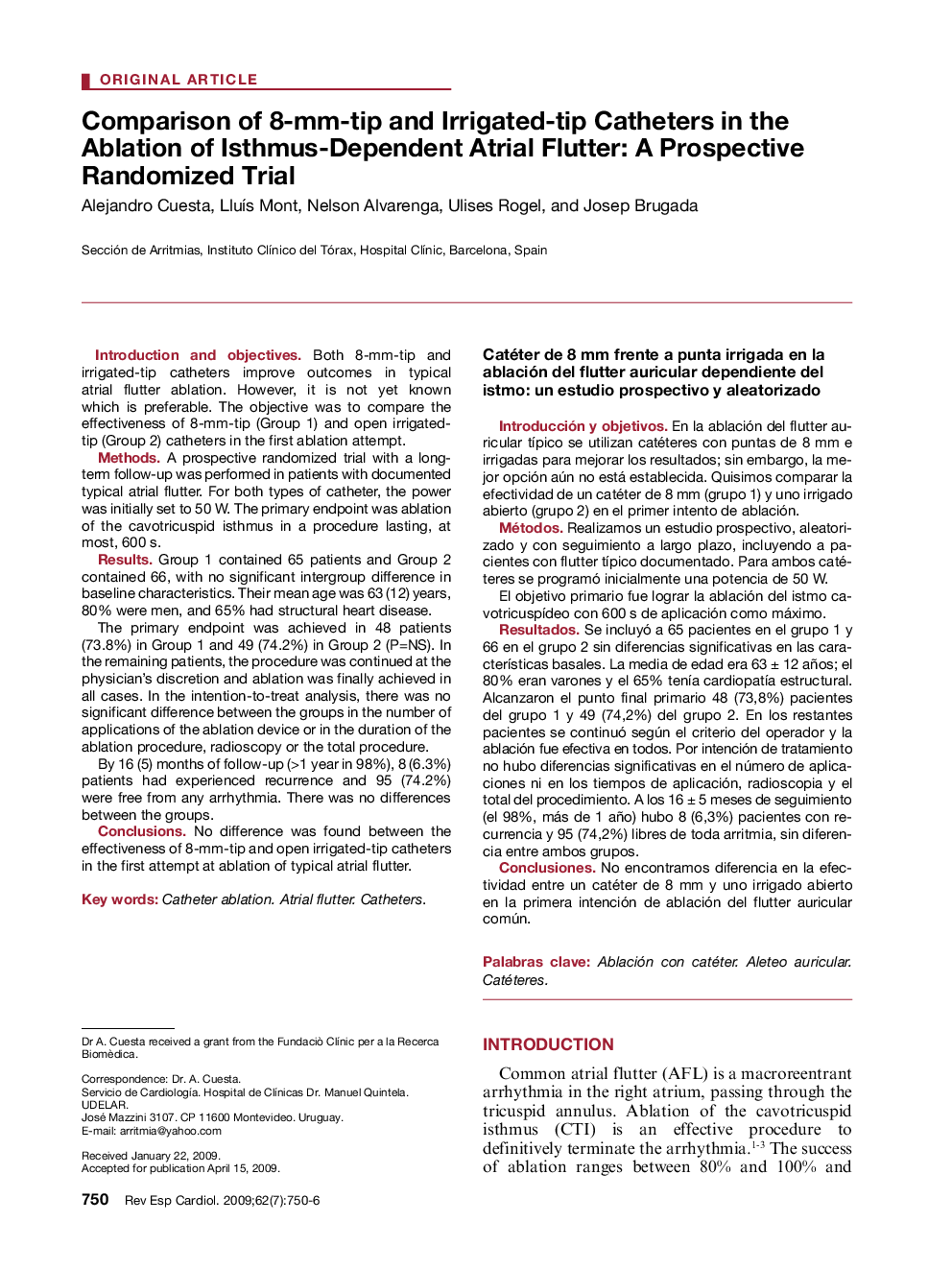| Article ID | Journal | Published Year | Pages | File Type |
|---|---|---|---|---|
| 3017380 | Revista Española de Cardiología (English Edition) | 2009 | 7 Pages |
Introduction and objectivesBoth 8-mm-tip and irrigated-tip catheters improve outcomes in typical atrial flutter ablation. However, it is not yet known which is preferable. The objective was to compare the effectiveness of 8-mm-tip (Group 1) and open irrigatedtip (Group 2) catheters in the first ablation attempt.MethodsA prospective randomized trial with a long-term follow-up was performed in patients with documented typical atrial flutter. For both types of catheter, the power was initially set to 50 W. The primary endpoint was ablation of the cavotricuspid isthmus in a procedure lasting, at most, 600 s.ResultsGroup 1 contained 65 patients and Group 2 contained 66, with no significant intergroup difference in baseline characteristics. Their mean age was 63 (12) years, 80% were men, and 65% had structural heart disease.The primary endpoint was achieved in 48 patients (73.8%) in Group 1 and 49 (74.2%) in Group 2 (P=NS). In the remaining patients, the procedure was continued at the physician's discretion and ablation was finally achieved in all cases. In the intention-to-treat analysis, there was no significant difference between the groups in the number of applications of the ablation device or in the duration of the ablation procedure, radioscopy or the total procedure.By 16 (5) months of follow-up (>1 year in 98%), 8 (6.3%) patients had experienced recurrence and 95 (74.2%) were free from any arrhythmia. There was no differences between the groups.ConclusionsNo difference was found between the effectiveness of 8-mm-tip and open irrigated-tip catheters in the first attempt at ablation of typical atrial flutter.
Introducción y objetivosEn la ablación del flutter auricular típico se utilizan catéteres con puntas de 8 mm e irrigadas para mejorar los resultados; sin embargo, la mejor opción aún no está establecida. Quisimos comparar la efectividad de un catéter de 8 mm (grupo 1) y uno irrigado abierto (grupo 2) en el primer intento de ablación.MétodosRealizamos un estudio prospectivo, aleatorizado y con seguimiento a largo plazo, incluyendo a pacientes con flutter típico documentado. Para ambos catéteres se programó inicialmente una potencia de 50 W.El objetivo primario fue lograr la ablación del istmo cavotricuspídeo con 600 s de aplicación como máximo.ResultadosSe incluyó a 65 pacientes en el grupo 1 y 66 en el grupo 2 sin diferencias significativas en las características basales. La media de edad era 63 ± 12 años; el 80% eran varones y el 65% tenía cardiopatía estructural. Alcanzaron el punto final primario 48 (73,8%) pacientes del grupo 1 y 49 (74,2%) del grupo 2. En los restantes pacientes se continuó según el criterio del operador y la ablación fue efectiva en todos. Por intención de tratamiento no hubo diferencias significativas en el número de aplicaciones ni en los tiempos de aplicación, radioscopia y el total del procedimiento. A los 16 ± 5 meses de seguimiento (el 98%, más de 1 año) hubo 8 (6,3%) pacientes con recurrencia y 95 (74,2%) libres de toda arritmia, sin diferencia entre ambos grupos.ConclusionesNo encontramos diferencia en la efectividad entre un catéter de 8 mm y uno irrigado abierto en la primera intención de ablación del flutter auricular común.
